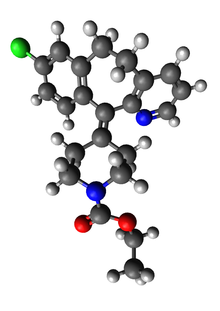- Loratadine
-
Loratadine 

Systematic (IUPAC) name Ethyl 4-(8-chloro-5,6-dihydro-11H-benzo[5,6]cyclohepta[1,2-b]pyridin-11-ylidene)-1-piperidinecarboxylate Clinical data Trade names Claritin AHFS/Drugs.com monograph MedlinePlus a697038 Pregnancy cat. B1(AU) B(US) Legal status GSL (UK) OTC (US) OTC(Canada) Routes oral Pharmacokinetic data Bioavailability almost 100% Protein binding 97–99% Metabolism Hepatic (CYP2D6- and 3A4-mediated) Half-life 8 hours, active metabolite desloratadine 28 hours Excretion 40% as conjugated metabolites into urine
Similar amount into the fecesIdentifiers CAS number 79794-75-5 
ATC code R06AX13 PubChem CID 3957 DrugBank DB00455 ChemSpider 3820 
UNII 7AJO3BO7QN 
KEGG D00364 
ChEMBL CHEMBL998 
Chemical data Formula C22H23ClN2O2 Mol. mass 382.88 g/mol SMILES eMolecules & PubChem  (what is this?) (verify)
(what is this?) (verify)Loratadine (INN) is a second-generation H1 histamine antagonist drug used to treat allergies. Structurally, it is closely related to tricyclic antidepressants such as imipramine, and distantly related to the atypical antipsychotic quetiapine.[1] It is marketed by Schering-Plough under several trade names such as Claritin, and by Shionogi in Japan. Loratadine is available as a generic drug and is marketed for its non-sedating properties. In a version named Claritin-D or Clarinase, the substance is combined with pseudoephedrine, a decongestant; this makes it useful for colds as well as allergies, but adds potential side-effects of insomnia, nervousness, and anxiety.
Contents
History
Schering-Plough developed loratadine as part of a quest for a potential blockbuster drug: a nonsedating antihistamine. However, by the time Schering submitted the drug to the U.S. Food and Drug Administration (FDA) for approval, the agency had already approved a competitor's non-sedating antihistamine, terfenadine (trade name Seldane), and, therefore, put loratadine on a lower priority as a "me too" drug.[2]
Loratadine was eventually approved by the FDA in 1993.[2] It accounted for 28% of Schering's total sales[citation needed]. The drug continued to be available only by prescription in the U.S. until it went off patent in 2002.[citation needed] It was then immediately approved for over-the-counter sales. Once it became an unpatented over-the-counter drug, the price dropped precipitously, and insurance companies no longer paid for it. In response, Schering launched an expensive advertising campaign to convince users to switch to desloratadine (descarboethoxyloratadine, trade name Clarinex), which is the active metabolite of loratadine. A 2003 study comparing the two drugs found that "There is no clinical advantage to switching a patient from loratadine to desloratadine. However, it may be an option for patients whose medical insurance no longer covers loratadine if the co-pay is less than the cost of the over-the-counter product."[3] However, as of 2009, 10 mg loratadine tablets can be purchased relatively inexpensively, as generic manufacturers offer 120-day supplies for less than $25.
Indications
Loratadine is indicated for the symptomatic relief of allergy such as hay fever (allergic rhinitis), urticaria (hives), and other skin allergies.[4] For allergic rhinitis (hay fever), loratadine is effective for both nasal and eye symptoms: sneezing, runny nose, itchy or burning eyes. Loratadine could be also used to treat mild to moderate pain from headaches.
Forms
 An example of a loratadine 10 mg tablet (Rx)
An example of a loratadine 10 mg tablet (Rx)
The drug is available as tablets, oral suspension, and syrup,[4] and also in combination with pseudoephedrine.[5] Also available are quick-dissolving tablets, which are marketed as being faster to get into one's circulatory system but which require special handling to avoid degrading in the package.
Cautions and contraindications
Patients with severe hepatic (liver) disorders may need to start with a lower dose. No-dose adaptation is necessary for elderly or renally impaired patients.[4][6]
Loratadine is usually compatible with breast-feeding (classified category L-2 by the American Academy of Pediatrics).[7] In the U.S., it is classified as category B in pregnancy, meaning that animal reproduction studies have failed to demonstrate a risk to the fetus, and there are no adequate and well-controlled studies in pregnant women.[8]
Adverse effects
As a 'non-sedating' antihistamine, loratadine causes less but still significant sedation and psychomotor retardation than the older antihistamines because it penetrates the blood brain barrier only to a smaller extent. Although drowsiness is rare at the common 10 mg dose, patients should, nevertheless, be advised that it can occur and may affect performance of skilled tasks (e.g., driving); there is no reason to avoid drinking alcohol while using loratadine, as no interaction between alcohol and loratadine can be demonstrated.
Other possible side-effects include headache and antimuscarinic effects such as urinary retention, dry mouth, blurred vision, and gastrointestinal disturbances.[4][6]
Lastly, in rare cases, loratadine has been shown to cause severe mood shifts with effects ranging from depression to rage.[9][unreliable source]
Mechanism of action
Loratadine is a tricyclic antihistamine, which acts as a selective inverse agonists of peripheral histamine H1-receptors.[6] Histamine is responsible for many features of allergic reactions.
Pharmacokinetics
Loratadine is given orally, is well absorbed from the gastrointestinal tract, and has rapid first-pass hepatic metabolism; it is metabolized by isoenzymes of the cytochrome P450 system, including CYP3A4, CYP2D6, and, to a lesser extent, several others.[10][11] Loratadine is almost totally (97–99%) bound to plasma proteins. Its metabolite desloratadine, which is largely responsible for the antihistaminergic effects, binds to plasma proteins by 73–76%.[4]
Loratadine's peak effect occurs in 1–2 hours, and its biological half-life is on average 8 hours (range 3–20 hours) with desloratadine's half-life being 28 hours (range 9–92 hours), accounting for its long-lasting effect. About 40% is excreted as conjugated metabolites into the urine, and a similar amount is excreted into the feces. Traces of unmetabolised loratadine can be found in the urine.[4]
Interactions
Substances that act as inhibitors of the CYP3A4 enzyme such as ketoconazole, erythromycin, cimetidine and furanocoumarin derivates (found in grapefruit) lead to increased plasma levels of loratadine. This had clinically significant effects in controlled trials of higher than usual doses of loratadine (20 mg).
Antihistamines should be discontinued approximately 48 hours prior to skin allergy tests since these drugs may prevent or diminish otherwise positive reactions to dermal activity indicators.
Legal status
In Canada, Mexico, the U.S., Australia, the UK and many other countries loratadine is available over the counter, as are some other second-generation antihistamines like cetirizine. In the UK, larger quantities are "P-Line" and can be sold only in the presence of a pharmacist. However, packets of up to and including 14 tablets are available "off the shelf" (GSL).[12]
References
- ^ Kay GG, Harris AG (July 1999). "Loratadine: a non-sedating antihistamine. Review of its effects on cognition, psychomotor performance, mood and sedation". Clinical and experimental allergy: journal of the British Society for Allergy and Clinical Immunology 29 Suppl 3: 147–50. PMID 10444229. http://www.blackwell-synergy.com/openurl?genre=article&sid=nlm:pubmed&issn=0954-7894&date=1999&volume=29&issue=&spage=147.
- ^ a b Hall, Stephen S. (2001-03-11). "The Claritin Effect; Prescription for Profit". The New York Times. http://www.nytimes.com/2001/03/11/magazine/the-claritin-effect-prescription-for-profit.html?pagewanted=1. Retrieved 2010-06-28.
- ^ See S (2003). "Desloratadine for allergic rhinitis". Am Fam Physician 68 (10): 2015–6. PMID 14655812. http://www.aafp.org/afp/20031115/steps.html.
- ^ a b c d e f Jasek, W, ed (2007) (in German). Austria-Codex. 1 (2007/2008 ed.). Vienna: Österreichischer Apothekerverlag. pp. 1768–71. ISBN 3-85200-181-4.
- ^ Jasek, W, ed (2007) (in German). Austria-Codex. 1 (2007/2008 ed.). Vienna: Österreichischer Apothekerverlag. pp. 1731–34. ISBN 3-85200-181-4.
- ^ a b c Mutschler, Ernst; Gerd Geisslinger, Heyo K. Kroemer, Monika Schäfer-Korting (2001) (in German). Arzneimittelwirkungen (8 ed.). Stuttgart: Wissenschaftliche Verlagsgesellschaft. pp. 456–461. ISBN 3-8047-1763-2.
- ^ Committee on Drugs (1 September 2001). "Transfer of drugs and other chemicals into human milk". Pediatrics 108 (3): 776–89. PMID 11533352. http://aappolicy.aappublications.org/cgi/content/full/pediatrics;108/3/776.
- ^ See, Sharon (November 15, 2003). "Desloratadine for Allergic Rhinitis". American Family Physician. http://www.aafp.org/afp/20031115/steps.html.
- ^ http://www.askapatient.com/viewrating.asp?drug=19658&name=CLARITIN
- ^ Nelson, Wendel L. (2002). "Antihistamines and related antiallergic and antiulcer agents". In Williams, David H.; Foye, William O.; Lemke, Thomas L.. Foye's principles of medicinal chemistry. Hagerstown, MD: Lippincott Williams & Wilkins. pp. 805. ISBN 0-683-30737-1. Retrieved on 1 December 2009 through Google Book Search.
- ^ Ghosal A, Gupta S, Ramanathan R, et al. (August 2009). "Metabolism of loratadine and further characterization of its in vitro metabolites". Drug Metab Lett 3 (3): 162–70. doi:10.2174/187231209789352067. PMID 19702548.
- ^ Medicines and Healthcare products Regulatory Agency: Recent reclassifications
External links
- Loratadine—MedlinePlus Drug Information, U.S. National Library of Medicine, National Institutes of Health
- Claritin (loratadine) drug description—RxList (Internet Drug Index)
- Claritin—patient information leaflet
- U.S. National Library of Medicine: Drug Information Portal - Loratadine
Tricyclics Classes Acridine • Anthracene • Dibenzazepine • Dibenzocycloheptene • Dibenzodiazepine • Dibenzothiazepine • Dibenzothiepin • Dibenzoxazepine • Dibenzoxepin • Phenothiazine • Pyridazinobenzoxazine • Pyridinobenzodiazepine • ThioxantheneAntidepressants 7-OH-Amoxapine • Amezepine • Amineptine • Amitriptyline • Amitriptylinoxide • Amoxapine • Aptazapine • Azepindole • Azipramine • Butriptyline • Cianopramine • Ciclazindol • Ciclopramine • Clomipramine • Cotriptyline • Cyanodothiepin • Demexiptiline • Depramine/Balipramine • Desipramine • Dibenzepin • Dimetacrine • Dosulepin/Dothiepin • Doxepin • Enprazepine • Esmirtazapine • Fluotracen • Hepzidine • Homopipramol • Imipramine • Imipraminoxide • Intriptyline • Iprindole • Ketipramine • Litracen • Lofepramine • Losindole • Loxapine • Maprotiline • Mariptiline • Mazindol • Melitracen • Metapramine • Mezepine • Mianserin • Mirtazapine • Naranol • Nitroxazepine • Nortriptyline • Noxiptiline • Octriptyline • Opipramol • Oxaprotiline • Pipofezine • Pirandamine • Propizepine • Protriptyline • Quinupramine • Setiptiline/Teciptiline • Tandamine • Tampramine • Tianeptine • Tienopramine • TrimipramineAntihistamines Alimemazine • Azatadine • Clobenzepam • Cyproheptadine • Dacemazine • Deptropine • Desloratadine • Epinastine • Etymemazine • Hydroxyethylpromethazine • Isopromethazine • Isothipendyl • Ketotifen • Latrepirdine • Loratadine • Mebhydrolin • Mequitazine • Methdilazine • Olopatadine • Oxomemazine • Phenindamine • Pimethixene • Promethazine • Propiomazine • Rupatadine • ThiazinamiumAntipsychotics Acetophenazine • Amoxapine • Asenapine • Butaclamol • Butaperazine • Carphenazine • Carpipramine • Chlorpromazine • Chlorprothixene • Ciclindole • Clocapramine • Clomacran • Clotiapine • Clozapine • Flucindole • Fluotracen • Flupentixol • Fluphenazine • Gevotroline • Homopipramol • Levomepromazine/Methotrimeprazine • Loxapine • Maroxepin • Mesoridazine • Metitepine/Methiothepin • Metoxepin • Mosapramine • Naranol • Olanzapine • Perazine • Perphenazine • Periciazine • Piperacetazine • Pipotiazine • Piquindone • Prochlorperazine • Promazine • Prothipendyl • Quetiapine • Sulforidazine • Thiethylperazine • Thiopropazate • Thioridazine • Thiothixene • Trifluoperazine • Triflupromazine • Zotepine • ZuclopenthixolOthers Atiprosin • Carbamazepine • Carvedilol • Cyclobenzaprine • Licarbazepine • Methylene Blue • Monatepil • Oxcarbazepine • Oxitriptyline • Pirenzepine • Pirolate • Pitrazepin • Pizotifen • ProfenamineCategories:- H1 receptor antagonists
- Carbamates
- Schering-Plough
- Wyeth
- Piperidines
- Organochlorides
- Benzocycloheptapyridines
Wikimedia Foundation. 2010.
